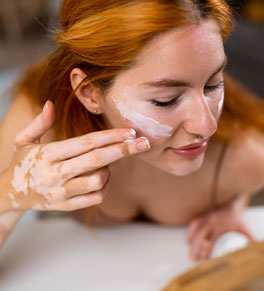Acne Scar Treatment and Scar Revision
Long after adolescence, millions of people suffer the lasting effects of acne. Scars from acne or other causes can detract from your appearance and confidence. Today a variety of techniques and treatments can improve the appearance of acne and other scars and boost esteem.
Our UCI Health aesthetic surgeons and dermatologists are among the most experienced in Orange County and the region in these treatments, including laser surgery.
The choice of technique or combination treatment depends on the type of scarring, the patient’s medical history, as well as the expertise and lasers or other equipment available to the physician. Our physicians carefully evaluate your skin and work with you to develop an individually tailored treatment program.
Scar revision
Most scars can be improved by modern interventions. This may include surgical revision and excision, laser therapy, intralesional injections and topical creams. For many patients, a combination approach is indicated.
Not all scars improve dramatically with treatment, but we work with you to explain the potential benefits and possible risks of treatment.
New lasers, such as the Fraxel Repair and Fraxel Restore, have significantly enhanced our ability to improve the appearance of scars. These treatments generally require little after-care and often produce dramatic results.
Patients at our Dermatology Center can count on the expertise of our team of dermatologists and their skill with the latest techniques and equipment to significantly improve the appearance of acne and other scars.
To schedule a consultation or seek more information, please call us at 949-824-0606.
Acne Scarring
There are many different types of acne scars, including boxcar scars, ice pick scars and rolling scars.
Depending on the type of scarring, many patients need a combination of treatments, including laser resurfacing, for best results.
Many patients need a combination of treatments, including laser resurfacing, for best results.
Boxcar scars
Boxcar scars are rectangular or sharply demarcated. Superficial scars can be improved with laser skin resurfacing, either fractionated or traditional.
Deeper scars may be best treated by surgical removal. Excision with stitches, in combination with treatment by one of various laser devices available, can produce impressive results.
This type of scarring often responds well to fractionated devices, such as the Fraxel Restore or Repair lasers.
Ice pick scars
Ice pick scars are deeply pitted. Surgical removal or focal chemical-peel treatments are the optimal methods to treat small pitted scars. With surgical removal, as many as 15 to 20 scars can be removed in one session.
Most patients benefit from a follow-up treatment of skin resurfacing with one of several types of lasers. The laser treatment is usually performed four to six weeks after surgery.
In some cases, our cosmetic surgeons perform surgical excision of the scars immediately after laser resurfacing. Patients usually notice an improvement in four to six weeks.
Rolling scars
Rolling scars have an undulating appearance on the skin. They are best treated with soft tissue fillers such as Juvederm or Restylane, which can improve their appearance.
Fillers also may be used in combination with other aesthetic procedures, such as undermining the scar with a tiny blade or needle, a process called subcision.
This process is often used under deep lines on the face in the nasolabial folds and under depressed scars, flaps or grafts.
Laser Resurfacing
Traditional laser resurfacing is one of the most useful techniques in the treatment of acne scarring. We generally use an erbium YAG laser for this procedure, but the CO2 laser is equally as good.
At the UCI Health Dermatology Center, we use two different classes of fractionated devices: fractional ablative and fractional non-ablative.
Ablative lasers
Fractionated ablative devices include the Fraxel Repair, the Sciton ProFractional and Cutera Fractional Pearl. These vaporize the skin in a fractional manner, meaning that they create myriads of tiny, very narrow cylinders of vaporization to a depth of about 1.5 millimeters over the entire face.
Each area of vaporization is surrounded by entirely normal untreated skin. This allows these damaged zones to heal very quickly, and without scarring.
Nonablative lasers
The Fraxel Restore and the Cynosure Affirm non-ablative lasers work similarly, but without vaporization. It is a much gentler treatment and is associated with shorter healing time after treatment.
Performed as a series of five or six treatments about once a month, Fraxel Restore laser treatment helps to smooth acne scars as well as fine-to-moderate wrinkles.
Sunburn-like redness and swelling for a day or two are usually the only after effects of this procedure.
Microdermabrasion & Chemical Peels
Microdermabrasion
Think of a device that sandblasts grime and debris off granite buildings, and you get an idea of microdermabrasion. Small particles pass through a vacuum tube remove the top layer of the skin, which is thought to stimulate new cell growth.
Microdermabrasion works best for acne scarring when used in combination with other topical treatments such as Retin-A, bleaching agents and other rejuvenating creams.
Because of the superficial nature of this technique, patients with mild scarring are the best candidates. Multiple treatments are usually required to achieve subtle results.
The new DermaSweep device uses a nylon or steel brush infusion technique, which produces good results in patients with mild to moderate acne and acne scarring.
Chemical peels
Mild acne scarring and certain types of acne may be successfully treated by the application of a chemical peel solution.
This allows new and regenerated skin to appear, improving the skin's appearance.








